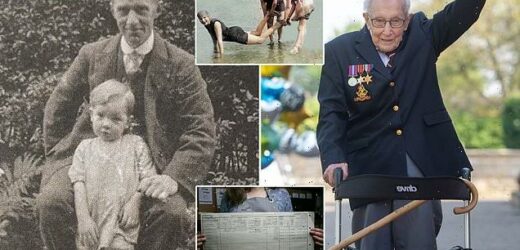The way we were… 100 years ago: More than 40,000 orphans, over a million servants, and 1.7m more women than men. In utterly absorbing new detail, a snapshot of a nation still recovering from ravages of WWI
- The 1921 census forms were delivered to 8.5 million homes on June 19, 2021
- Some disgruntled Britons used them to vent their anger after the First World War
- There were around 1.7 million more women than men after the bloody conflict
- The census of England and Wales has been completed every ten years since 1801
- Documents are legally required to remain secret for 100 years
With the UK still reeling from the First World War and the Spanish flu pandemic raging, it was a grim time of economic turmoil, soaring unemployment and social unrest.
And, despite Liberal Prime Minister David Lloyd George’s ambition to build ‘homes fit for heroes’, there was a housing crisis which left many families crammed into a single room.
So when the 1921 census forms were delivered to 8.5 million homes, some disgruntled Britons used them to vent their anger – going beyond the required details of name, age, occupation, marital status and address on June 19, 1921.
Gas fitter James Bartley, 33, who lived with wife May and their three children aged under five in Hove, East Sussex, wrote on his form: ‘Five persons living in one room. Stop talking about your homes for heroes and start building some houses – and let them at a rent a working man can afford to pay.
Findmypast and The National Archives today publish the highly anticipated 1921 Census of England and Wales online, as the 100-year rule, which ensures records are closed to the public for 100 years, has ended
Desperate Robert Stevens, 44, an out-of-work father of 13, who lived with his wife Agnes and their brood in five rooms on the Wirral in Merseyside, wrote: ‘Can you help us? Times are hard.’ Full details of the 1921 census, which lists 38million residents in England and Wales, was published yesterday after a three-year project by the National Archives and genealogy website Findmypast to conserve and make digital the millions of pages.
Sherlock writer’s date with the dead
Sherlock Holmes author Sir Arthur Conan Doyle is thought to have been holding a seance to contact the dead when the 1921 census was taken.
Three guests were present at the writer’s home in Crowborough, East Sussex, on the night of the census alongside his wife Jean, their three children and five servants.
These were parapsychologist James Hewat McKenzie, founder of the British College of Psychic Science, his wife Barbara and a ‘spinster’ entered as ‘Ada Bassinet’ – but believed to be medium Ada Besinnet.
One historian said handwritten, unsought additions to the forms showed people ‘using the census the way many of us use Twitter today – we’ll copy in someone in a position of power on a tweet complaining about something’.
Other Britons used their forms to criticise the cost of the census, which was delivered to households by 38,000 dedicated staff. ‘What a wicked waste of taxpayers’ money at this time of unemployment,’ wrote Alice Underwood, 53, from Slough, Berkshire.
Albert Dunn, 46, of Little Stukeley, Cambridgeshire, who listed his occupation as a ‘reformer’ and his place of work as ‘God’s and my own account’, returned his form stained after disinfecting it in a bid to avoid catching the Spanish flu which killed up to 100million worldwide after breaking out in 1918.
He wrote: ‘Slight accident with crude carbolic in cause of necessary disinfection of all transmission and exchanges in this pre-historic village. Please be good enough to refer to Board of Health… for report of the illness here and ask them to appoint an investigator.’
The legacy of war is clear – there were 1,096 women for every 1,000 men – the highest difference since the census began in 1801.
August 1921, England, Herne Bay, Three young women in bathing suits enjoying themselves in the sea
Emily Briffet, a Findmypast conservation technician holds the 1921 Census return for Thomas Moore, better known as Sir Captain Tom.
George V had more than 150 servants at Windsor Castle during the 1921 census.
The King was present that night with Queen Mary and four of their adult children – Edward, Albert, Henry and Mary, while Prince George, 18, was listed as serving on board HMS Iron Duke, off Malta.
There were almost 40 visitors present at the castle, including King Alfonso XIII of Spain.
A total of 151 people are listed as servants, including 36 housemaids, 18 footmen, 17 valets and four wine cellar staff.
The youngest was ‘under housemaid’ Maud Alice Swoad, 15, from Kensington.
That meant there were around 1.7 million more women than men, underlining the deadly toll of the war which finished three years earlier. The figures also show the UK had more than 41,000 orphans while a million women worked as servants – the main job for females at the time – and the coal industry was the biggest employer of men.
A total of 2.5 million Britons were unemployed – a rate of 23.4 per cent of those covered by national insurance legislation at the time.
Retired Army officer Harold Orpen, 46, of Paddington, west London, who gave a typed response rather than the required handwritten one, added a note saying: ‘I regret not being able to fill up this schedule in ink as directed but I lost half my right hand in the late war and cannot write properly.’
Tax officer Arthur Vince, 28, defaced his form with a political cartoon depicting officials in top hats ‘counting cannon fodder’ for the ‘next war’, which he predicted would be in 1936.
An annotation to his drawing – of a woman serving three men at a table – says they are ‘counting available cannon fodder. Next war 1936.’ It is believed that Mr Vince’s son Bobby, who was included in the 1921 census aged one year and four months, was among those killed in the Second World War, which began in 1939.
The 1921 census was more detailed than any before and residents were able to declare their marital status as ‘divorced’ for the first time.
Around 16,000 did so, but the true figure is thought to be much higher due to the social stigma over failed marriages at the time.
Henry Forrest, 42 an unmarried teacher from Manchester, objected to a divorce question even being asked on the form, writing on it that the issue was a ‘curse to the country.’
This record from the 1921 Census provides the details of renowned author, journalist and historical commentator Herbert G. Wells (H.G. Wells) and his wife Amy
But, in an example of Britons’ resilience and unbowed sense of humour, census form-fillers were still able to joke about life.
Albert Crockford, 31, a printer from London, married to Florence, described their three-year-old daughter Joan’s occupation as ‘keeping mum busy’.
Constance Bernard Fitzhamon, of Middlesex, listed her three children’s occupations as ‘getting into mischief’, ‘getting into more mischief’ and, for her youngest child, ‘occupying feeding bottles’.
D-Day hero to bargemaster
D-Day veteran Edwin Hunt, who went on to be the Queen’s bargemaster, was nearly 15 months old at the time of the census.
Now aged 102, Ted became an apprentice waterman on the Thames in 1935. He commanded 15 ferries on D-Day in 1944.
After the war he lectured in watermanship before becoming Queen’s Bargemaster in 1978, escorting visiting heads of state and being responsible for transporting the crown at state openings of Parliament.
He retired in 1990.
The nation’s love of their pets also shone through, with many families listing them among their household. The Webb family in Lancashire included ‘Teddy the dog’. However, census officials did not see the funny side.
One entry for ‘Kitty the cat’ from Francis Sutcliffe, of Kirkdale, Lancashire, was crossed out by an official who explained it was just ‘a domestic cat’.
Beatrix Potter had a long-established career as a top writer of children’s stories following the success of The Tale Of Peter Rabbit in the early 1900s.
But it was another profession – and her married name – that appeared on the 1921 census.
Helen Beatrix Heelis, the 54-year-old wife of solicitor William Heelis, was described as a ‘farmer’ due to her passion for sheep breeding and conservation at her home in the Lake District.
Photos of other census forms show the signatures of fellow acclaimed writers, including Winne-the-Pooh creator AA Milne, science fiction author HG Wells and JRR Tolkien, who went on to write The Hobbit in 1937 and The Lord of the Rings trilogy in the 1950s.
The census of England and Wales has been completed every ten years since 1801, except for 1941 amid the Second World War, but documents are legally required to remain secret for 100 years.
Taking his first steps in life, Captain Sir Tom Moore (age 1)
He went on to raise £33million for the NHS by completing laps of his garden as he turned 100. But at the time of the 1921 census, the future Captain Sir Tom Moore was taking his first steps in life.
He was just a year and one month old when the census was completed and living with his father Wilfred, 36, a building contractor, mother Isabel, 34, whose occupation was listed as ‘household duties’, and sister Freda, four, in a six-bedroom property in Keighley, West Yorkshire.
Our photograph from the family album shows him aged around two years old with his father.
In his book, Tomorrow Will Be A Good Day, the Second World War veteran recalled an extremely happy childhood growing up on the southern slopes of Rombalds Moor – renowned as ‘Bronte Country’.
Captain Tom Moore and his father Wilfred Moore. The family doesn’t know exactly when it was taken, but Tom looks like he’s about 2 years old here
File photo dated 16/04/2020 of Captain Sir Tom Moore who died in 2021
He recalled the family home having no electricity but candles and some lighting by gas. It was ‘relatively modern’ compared with many in the town, he said, having a coal-fired range and a separate gas oven as well as an inside flush toilet.
He also told how he went into hospital with scarlet fever when he was five but ‘it didn’t affect me long term and I was soon back home and running around as usual’.
Captain Sir Tom was long at ease with the knowledge that even he could not go on forever. ‘I have often thought that when I die, I shall once more see all the people I’ve loved who have gone ahead,’ he said.
‘So, even if tomorrow is my last day, if all those I loved are waiting for me, then that tomorrow will be a good day too.’
He died from pneumonia with coronavirus in February last year.
Source: Read Full Article









